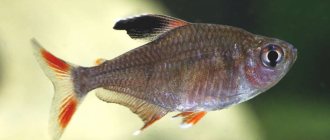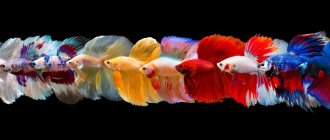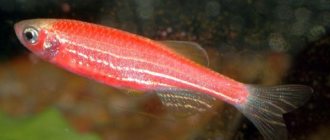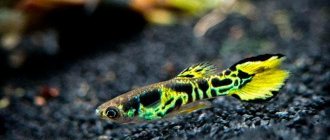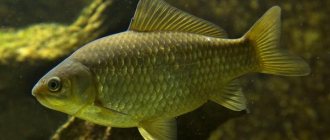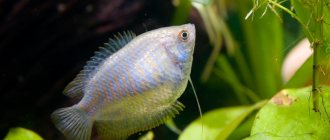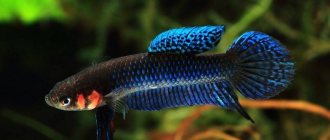Habitat in nature
Like the goldfish, the comet is an artificially bred breed and is not found in nature.
According to the main version, it appeared in the USA. It was created by Hugo Mulertt, a government official, in the late 1880s. Comet was successfully introduced into Government Fish Commission ponds in Washington County.
Later, Mullert began to actively promote goldfish in the United States and wrote several books about keeping and breeding these fish. It was thanks to him that this fish became popular and widespread.
But there is also an alternative version. According to her, this fish was bred by the Japanese, and Mullert created the American type, which later became widespread. However, the Japanese themselves do not claim to be the creators of the breed.
Feeding the fish
Like many aquarium fish, the comet is not picky about food. She is quite happy with live and frozen food (for example, seafood, bloodworms, earthworms, etc.), herbal supplements in the form of crushed lettuce leaves, nettles, and special food for goldfish.
Comets are very voracious and prone to obesity , so it is recommended to feed them strictly on a schedule. Typically, adult fish are fed twice a day, and the amount of food is given for 10-20 minutes of eating. Uneaten excess is then removed from the aquarium so as not to poison the water with rotting products.
These fish are prone to obesity
Water
Comets are not particularly sensitive to changes in the chemical parameters of the water in the aquarium. The optimal temperature for goldfish is within +18...+23 °C, but they will easily tolerate fluctuations from +18 to +30 degrees.
Water hardness should be in the range of 8–23, acidity – 6–8. The comet will feel comfortable with weekly changes of 1/4 of the water in the aquarium. These fish need increased aeration and water filtration.
We recommend reading about what to do if the water in your home aquarium turns green and cloudy.
Aquarium volume
The aquarium for comets should be quite spacious - at least 50 liters of water per adult, and 100 liters for a pair. By increasing the volume of the container, you can increase the population density of fish.
We recommend reading about how to make and equip a large aquarium yourself.
For example, in an aquarium with a volume of 150 liters you can already stock 4 comets, and in a 200-liter aquarium you can stock all 6. But do not forget about aeration - the more fish in the aquarium, the more intense it should be.
Soil and plants
The favorite pastime of representatives of this species is to dig around in the ground, so the bottom of the aquarium should be covered with fine gravel, pebbles or coarse sand. This will contain the comets in their desire to redesign the landscape.
Plants for an aquarium with comets should be chosen large-leaved with a strong root system, for example, nomaphyla straight or aponogeton. The fact is that the comet will simply spoil more delicate plants by gnawing on their thin shoots.
Did you know? The goldfish sleeps at night, but with its eyes open.
Lighting
Good lighting in an aquarium with comets is necessary not only for plants, but also for fish, since in low light their bright colors fade greatly.
Place the aquarium near a sunny window or equip it with fairly bright electric lighting for at least 10–12 hours a day. The optimal ratio should be within 0.5 W per 1 liter of water.
Scenery
The design of an aquarium and its decoration is a matter of taste of its owner. But when choosing driftwood, locks, stones and other decorative elements for goldfish, make sure that they do not have sharp edges. The fins and body itself of comets are very delicate, protect them from damage.
Description
The main difference between a comet and a goldfish is the tail fin. It is single, forked (fork) and long. Sometimes the length of the caudal fin exceeds the length of the fish’s body.
The most common body color is yellow or golden, but there are red, white and white-red fish. The red color is most often found on the caudal and dorsal fin.
Body size up to 20 cm, but usually they are slightly smaller. Life expectancy is about 15 years, but under good conditions they can live longer.
Description of appearance
Comet is a decorative variety of goldfish from the carp family, bred through selective breeding at the end of the 19th century. Where she comes from remains a mystery to this day. Some attribute it to American origin, others to Japanese origin. Individuals are distinguished by a chic, bushy tail , the length of which is many times greater than the size of the entire body. The forked parts of the tail hang smoothly down, resembling beautiful golden ribbons.
The comet is characterized by a graceful, elongated physique . Its long dorsal and ventral fins harmonize perfectly with its chic fan-shaped tail, making the fish look very proportional and harmoniously built. The color of a comet can be very diverse. The rarest and, accordingly, valuable are fish with silver scales and bright red fins.
In most cases, the body of the comet has a reddish color with a golden tint, and there are white and yellow spots throughout the body. According to experts, the color of the comet can change depending on the diet, conditions of detention and parameters of the aquatic environment in the aquarium. In order for the color of the fish to be as bright, saturated and pleasing to the eye as possible, it is recommended to create appropriate conditions for it:
- varied, fortified diet;
- bright intense backlight;
- the presence in the artificial reservoir of a sufficient amount of green space creating natural shading.
Comet is a wonderful pet that can become a worthy decoration for any even medium-sized aquarium, since the size of an adult individual, as a rule, does not exceed 18 cm.
Difficulty in content
One of the most unpretentious goldfish. They are so unpretentious that they are most often kept in outdoor ponds along with KOI carp.
However, keeping it in a home aquarium has its limitations. First of all, comets need a spacious, large aquarium. Don’t forget that they grow up to 20 cm, and also swim actively and briskly.
In addition, these fish feel better in cool water, and when kept with tropical fish, their life expectancy is significantly reduced. This is due to the fact that metabolic processes occur faster in warmer water.
In this regard, it is recommended to keep them in species aquariums with similar fish.
Comet
Comet - goldfish
Order, family: carp. Comfortable water temperature:
20-23 C. Ph: 5.0-8.0. Aggressiveness: non-aggressive. Compatibility: with all peaceful fish (zebrafish, thorns, speckled catfish, etc.), but it is better to keep it separately in a species aquarium.
Comet is one of the fish included in the so-called “Goldfish” family. The fish is unusual and very beautiful.
The comet's body is elongated with a long, ribbon-like, forked caudal fin. The higher the assessment of a fish specimen, the longer its caudal fin. Comets are very similar to veiltails.
The color options for the comet are different. Of particular value are individuals whose body color is different from the color of their fins. The main color of the body is red-orange with the occasional presence of white and yellow. The color of the fish is affected by the degree of lighting in the aquarium and the food. The best way to preserve the original colors of the comet goldfish is live food, good lighting and the presence of shaded areas in the aquarium. The length of the fish is up to 18 cm, life expectancy is about 14 years.
These fish are not very picky about their living conditions. The main thing when keeping it is proper feeding - the key to success is the balance of feed. The fish is susceptible to intestinal diseases and overeating.
For maintenance you need a spacious aquarium with clean water - without nitrogen compounds. Neighbors should not be active and especially aggressive fish - barbs, cichlids, gourami, etc. You need to keep comets in an aquarium with a volume of at least 50 liters per fish, it is better if it is an aquarium of at least 100 liters, in which a couple of fish will be placed.
Comfortable water parameters: temperature 20-23 C, aquarium water hardness 6-18, pH 5.0-8.0. Enhanced aeration and filtration.
The peculiarity of the fish is that it loves to rummage in the ground. It is better to use coarse sand or pebbles as soil, which are not so easily scattered by fish. The aquarium itself should be spacious and species-rich, with large-leaved plants.
The fish are unpretentious when it comes to food. They eat quite a lot and willingly, so remember that it is better to underfeed the fish than to overfeed them. Adult fish are fed twice a day - morning and evening. Feed is given as much as they can eat in about 3-5 minutes, and any uneaten food should be removed.
Feeding any aquarium fish should be correct: balanced, varied. This fundamental rule is the key to the successful keeping of any fish, be it guppies or astronotuses. The article “How and how much to feed aquarium fish” talks about this in detail; it outlines the basic principles of the diet and feeding regime of the fish.
In this article, we note the most important thing - feeding fish should not be monotonous; the diet should include both dry food and live food. In addition, you need to take into account the gastronomic preferences of a particular fish and, depending on this, include in its diet food either with the highest protein content or, conversely, with plant ingredients.
Popular and popular food for fish, of course, is dry food. For example, you can constantly and everywhere find food on aquarium shelves - the leader of the Russian market; in fact, the range of food for this Tetra is included as individual food for a specific type of fish: for goldfish, for cichlids, for loricariids, guppies, labyrinths, arowanas, discus, etc. .d. Tetra has also developed specialized foods, for example, to enhance color, fortified, or for feeding fry. You can find out detailed information about all Tetra feeds on the company’s official website -
It should be noted that when purchasing any dry food, you should pay attention to the date of its manufacture and shelf life, try not to buy food in bulk, and also store the food in a closed state - this will help to avoid the development of pathogenic flora in it.
Comets reproduce independently, without any hormonal injections or without creating too specific conditions. Actual, good maintenance and proper feeding are the criterion and incentive for spawning of the spawners. All types of goldfish can spawn in small aquariums of 30 liters or more. However, better results can be achieved in larger aquariums or ponds. Detailed article about breeding comets.
All of the above is just the fruit of observing this type of aquarium fish and collecting various information from owners and breeders. We would like to share with visitors not only information, but also live emotions that allow us to understand the world of aquariums more fully and subtly. Register at https://fanfishka.ru/forum/, participate in discussions on the forum, create profile topics where you will talk about your pets in the first person and from the horse’s mouth, describe their habits, behavior and content, and share with us your successes and joys, share your experiences and learn from the experiences of others. We are interested in every bit of your experience, every second of your joy, every awareness of a mistake, which makes it possible for your comrades to avoid the same mistake. The more of us there are, the more pure and transparent drops of goodness there are in the life and everyday life of our seven billion society.
Comet fish is a bright representative of the carp family. The second name, which is often found among aquarists, is “goldfish”. This is the most beautiful representative of your aquarium, which, moreover, can get along well with all peace-loving fish.
The opinion that comet fish are very unclean is controversial. You just need to get a few catfish, which are considered aquarium orderlies. And you can enjoy the spectacle of beautiful and graceful representatives of the aquarium fauna. Beautiful photos are proof of this.
Keeping in an aquarium
The main content issues are described above. In general, they are very unpretentious fish, capable of living in completely different conditions.
For those who encounter these fish for the first time, it may come as a surprise how large they can be. Even those who understand goldfish often think that they are looking at pond KOIs, not comets.
Because of this, they need to be kept in the most spacious aquariums, despite the fact that adolescents are capable of living in small spaces. The minimum volume for a small flock is from 400 liters. Optimal - 800 or more. This volume will allow the fish to reach their maximum body and fin size.
When it comes to choosing a filter for gold, a simple rule works - the more powerful, the better. It is best to use a powerful external filter, such as the FX-6, charged with mechanical filtration.
Comets are active, eat a lot and love to burrow in the soil. This leads to the fact that the water quickly deteriorates, ammonia and nitrates accumulate in it.
These are cold-water fish and in winter it is better to do without a heater. Moreover, they need to be kept in a cool room, and in the summer, maintain a lower temperature in it using an air conditioner.
The optimal water temperature is 18°C.
Water hardness and pH do not matter much, but it is better to avoid extreme values.
Breeding comets
Breeding fish is not difficult. To do this, you will need a spawning tank with a volume of 30-40 liters, in which a mesh is placed on the bottom and a filter is turned on.
Fish begin to spawn at the age of two years. It is difficult to distinguish a male from a female. This can be done during the spawning period, most often in the first months of spring. At this time, the behavior of the pets is monitored. The males begin to chase the females and cling to them. In females, the abdomen becomes rounded from the eggs. In males, warty formations appear on the outside of the gill covers.
2-3 males and a female are placed in the prepared spawning tank. Before this, the producers are kept separately from each other for 2-3 weeks. Spawning is stimulated by raising the temperature to 28-30 degrees. During spawning, the female lays about 10 thousand eggs. As soon as spawning ends, the producers are removed to a common aquarium. The eggs develop in 3-4 days. The fry are fed with fry food.
Yellow
Feeding
Feeding is not difficult; it is an omnivorous fish that eats all types of live, artificial and plant foods. However, feeding has its own nuances.
Goldfish's ancestors ate plant foods, with animals representing a relatively small percentage of their diet. Neglect of this rule leads to sad consequences similar to intestinal volvulus.
A lack of plant fiber in the diet leads to the fact that protein feed begins to irritate the fish’s gastrointestinal tract, inflammation and bloating appear, the fish suffers and dies.
Bloodworms are especially dangerous because they have low nutritional value; fish cannot get enough of them and overeat.
Vegetables and food with spirulina will help cope with the problem. Vegetables include cucumbers, zucchini, squash and other soft varieties. You can give young nettles and other non-bitter plants.
Vegetables and herbs are first doused with boiling water, then immersed in water. Since they don’t want to drown, the pieces can be placed on a stainless steel fork.
It is important not to keep them in water for too long, as they quickly decompose and spoil the water.
Preparing the spawning tank
In the spawning area being prepared, it is necessary to create appropriate microclimatic conditions:
- The volume of the spawning tank is 25–30 liters.
- The bottom of the tank is filled with sandy substrate. Additionally, vegetation with small leaves is planted.
- Temperature – from 24 to 26 degrees.
- In order to stimulate future parents, the liquid in the reservoir is raised by 6 degrees.
- In order to preserve the eggs, a special mesh is placed at the bottom of the spawning tank. After all, goldfish not only reproduce, but also absorb eggs.
As soon as the spawning process is completed, the parents are removed from the spawning tank. Caviar develops without producers within 2–4 days. After this, fry appear in the spawning tank. In order to increase the likelihood of normal development, as well as to continue breeding, the temperature should be maintained at 23–25 degrees.
Since the fry are vulnerable, the most comfortable and gentle conditions are created in the aquarium. Experienced aquarists pay attention to nutrition. In the first days, the fry are fed with live dust. After 6–10 days, the following types of live food begin to be introduced:
- Ground rotifer.
- Artemia.
- Processed tubifex.
The fry should be transferred to a common tank after 2–3 months. This time is enough for them to gain strength.
Comet goldfish are amazing phenotypes that are preferred by experienced and novice aquarists. In order to admire them for 10–14 years, it is enough to observe certain conditions of maintenance and nutrition. To make the color of these fish appear better, the tanks are equipped with high-quality lighting and other devices.
Video about the spawning of comets and their correct content
AdminAuthor of the article
Did you like the article?
Share with your friends:
Compatibility
Comets are cold-water fish, so it is not recommended to keep them with tropical species. In addition, their long fins can become a target for fish that like to tug on their neighbors' fins. For example, Sumatran barb or ternetia.
It is ideal to keep them separately from other species or with goldfish. And even among the gold ones, not everyone will suit them.
For example, oranda needs warmer water. Goldfish and Shubunkin will be good neighbors.
